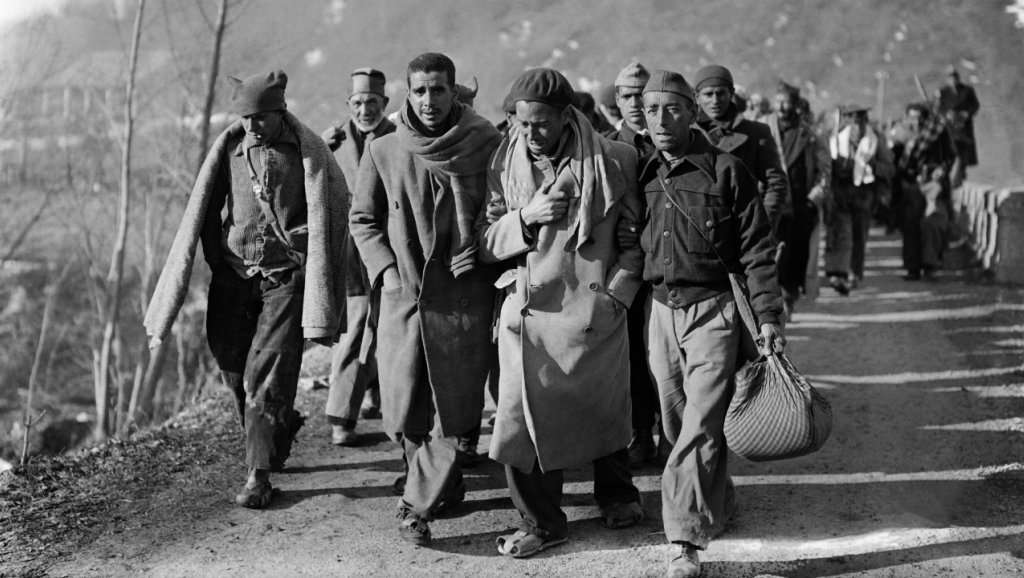The Painful Past of Spanish Civil War Refugees in France, 80 Years On

AFP | Spanish Republican soldiers fleeing Gen. Francisco Franco’s forces arrive in France in February, 1939.
Editor’s Note: This article first appeared on France24 and is reprinted here with the author’s permission.
Nearly half a million Spaniards crossed the border into France after Barcelona fell to General Francisco Franco 80 years ago. Many were detained in makeshift internment camps during a dark chapter of French history that has been all but forgotten.
In a matter of weeks, around 475,000 refugees had crossed the French-Spanish border. The exodus came to be known later as La Retirada (The Retreat). To mark its 80th anniversary, FRANCE 24 spoke to Geneviève Dreyfus-Armand, historian and author of “The Exile of Spanish Republicans in France: From the Civil War to Franco’s Death”, who explained this forgotten chapter in history.
What caused this massive influx of Spanish refugees?
How did they make the journey to France?
Dreyfus–Armand: They most often left on foot, but sometimes by cart or in a truck. The long column of refugees was the target of intense bombardments by Nationalist and Italian planes. They were running for their lives across the mountains in the heart of winter, in the cold and snow. There are absolutely horrible images of civilians and soldiers marching through the snow.

A photo dated February 1939 of a woman and her child arriving on foot in the southeastern French border town of Perthus. AFP
How did the French government react to the influx of Spanish refugees?
Dreyfus-Armand: The French government had long been aware that a wave of refugees would follow if Franco’s forces won the war. But no one was prepared for such a massive influx. The Spanish Republican government still hoped, against all reason, to reverse the situation. Meanwhile, the French government refused to act on what it knew, instead enforcing existing asylum laws. But the country had recently approved harsher rules for refugees, which allowed for asylum seekers from undesirable countries to be detained at internment camps.
This meant that families who arrived at the border were separated. Women, children, the elderly and the wounded were relocated to regions across France… Soldiers and able-bodied men were escorted to areas such as the beaches in the southeastern towns of Argelès-sur-Mer and Saint-Cyprien, where nothing had been prepared. All that had been set up was a perimeter of barbed wire. At first, there were around 100,000 men on the beaches in Argelès-sur-Mer, and slightly fewer in Saint-Cyprien. But the camps were soon overwhelmed, and others were built in neighbouring regions. It was totally improvised; the refugees didn’t have shelter at first. They buried themselves in the sand for protection. They built their own makeshift barracks. There was no drinking water and the mortality rate was extremely high during those initial weeks.
What happened in the following weeks?
Dreyfus–Armand: The camps emptied out in the spring of 1939. After fighting for nearly three years in Spain, this detention was unbearable for many of the men. But they had limited options. They could return to Spain, where former soldiers were often imprisoned or put to forced labour; immigrate elsewhere, such as Latin America; or enlist in the French military.
At the border, French authorities encouraged Spanish Republicans to join the Foreign Legion. Several thousand signed up, but the vast majority were able to escape the camps by finding work. They were hired by farmers or recruited by companies because many were highly skilled workers. By April 1940, there were around 100,000 Spaniards working in the war economy.
But after Germany occupied France in June 1940, many Spanish Republicans found themselves again interned in camps. They were forced into foreign labour units or conscripted to shore up defences at the border. Some were deployed to areas in non-occupied France, such as the Pyrénées or the Massif Central, where they cut wood. It was in these regions that they formed small pockets of resistance.
In 1944, they took part in the liberation of a number of French regions. The first armoured vehicle to enter Paris in August 1944 was driven by Spanish Republicans. At the end of the war, around 150,000 stayed in France. In March 1945, the Provisional Government of the French Republic recognised them as Nansen refugees (a special status that allowed stateless people to travel between countries).
Eighty years on, what remains of this chapter in history?
Geneviève Dreyfus–Armand: It’s a chapter in history that had a major impact on France. Yet we have a poor collective memory of it. Spanish Republicans didn’t expect to be welcomed in three-star hotels, but they also didn’t think that they would be humiliated and treated as poorly as they were, because they deeply admired France. For them, it was the country of human rights. Despite everything, they fought for France. Many took part in the war economy, and then the French Resistance. It’s an open wound for their descendants, because their actions were never recognised. They have become forgotten soldiers. They had the misfortune of arriving in France at a time when it no longer offered asylum. We soon forgot the tragedy because of World War II, but it has re-emerged in our collective conscience over the last 15 years or so. It’s important for their descendants, because this chapter in history has shaped their lives and continues to shape the world today.
This article was translated from the original in French.













